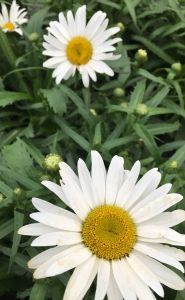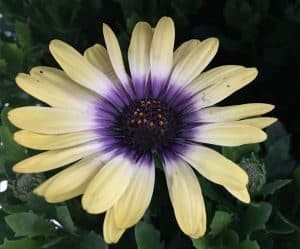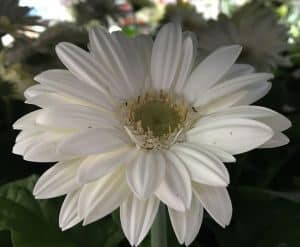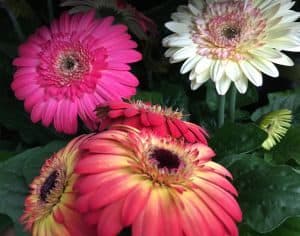
Shasta Daisy – Leucanthemum x superbum
No other flower brings to mind purity, cottage, country gardens to me as much as the Shasta Daisy. The white flowers are simple and beautiful. The flower also symbolizes innocence, loyal love, beauty, patience and simplicity. Daisies are often depicted in meadows in Medieval paintings. They are also known as a “flowery mead.” Daisies are believed to be more than 4,000 years old. Egyptian ceramics were decorated with daisies. Daisies were and are still used in Mary Gardens.
The Shasta daisy is a member of the Asteraceae family (known as the aster, daisy, or sunflower family) is the largest family of flowering plants. The name ‘Asteraceae‘ is derived from the genus Aster, meaning star. Asteraceae are most common in the temperate regions and tropical mountains.
The name daisy comes from “day’s eye” because the flower is only open during the day and closes at night. Another name is “thunderflower” since it blooms in the summer when thundershowers are common. In addition, the daisy is believed to keep away lightening. For this reason, it was also kept indoors. A common name in England for the flower is “bruisewort” since the crushed leaves could be used for soothing bruised or chapped skin.
Some important plants in the daisy family include the food crops lettuce, chicory, globe artichoke, sunflower, safflower and Jerusalem artichoke. Others include flowers used as herbs and in herbal teas and other beverages. Chamomile and calendula are grown for herbal teas and potpourri. Echinacea is used as a medicinal tea.
Daisy flowers are 2 to 3 inches typically have white petals with a yellow center. Flowers may be single or double. Shasta daisy make good meadow, cottage or bedding plants in addition to providing cut flowers attractive arrangements. This plant grows best in full sun with loose well-drained soil as root rot can be a problem for our area. This can be solved by adding sand and compost to soil or raising plant beds. Plants should be divided every other year to encourage larger flowers and a more compact and dense plant mass. Plants become unproductive if left unattended for years. Fertilize once during the growing season with a complete fertilizer like 13-13-13.
Propagate Shasta daisies by taking cuttings in late summer from June to August or dividing clumps. Reset plants in well-drained soil after dividing them in Fall. Old flowers should be dead-headed to encourage more flowers. Some varieties of daisies are ‘Alaska, Becky’, ‘Lucille White’, ‘Switzerland’, ‘White Swan’.
There are many variations and hybrids of the daisy which are named for the hybridizer or discoverer. African daisies or Osteospermum or Gerbera daisies look like Shasta daisies and are in the same family but are tender for our area. African daisies should be treated like annuals. They come in brighter colors like yellow, orange and hot pinks and more. The plants are generally shorter with wider and varied leaf shapes. The flowers are bigger with rounded and more petals than the Shastas. Some varieties are ‘Gerbera Jamesonii’, ‘Blue Eyed Beauty’.

submitted by Karen Blackburn



